LED01 – First-principles computation of charge-carrier recombination coefficients in optoelectronic materials
Charge-carrier recombination plays a decisive role in determining the efficiency of optoelectronic materials and devices, but their accurate experimental measurements and interpretation are challenging. In this context, first-principles computation of charge-carrier recombination coefficients is particularly useful. It allows not only rigorous computation of the recombination rates, but also intuitive interpretation of the microscopic recombination mechanisms […]














